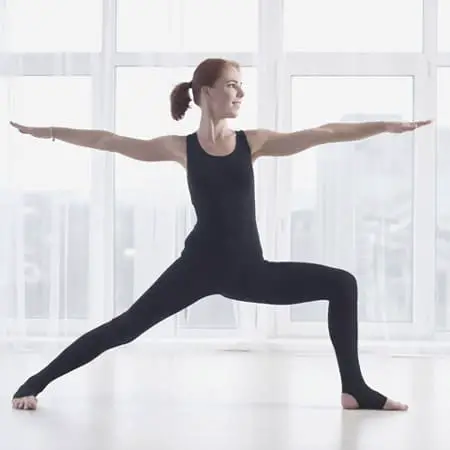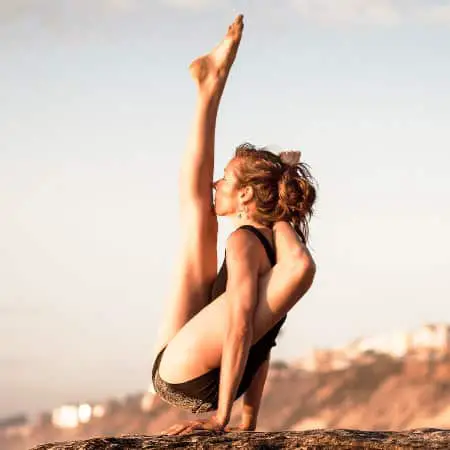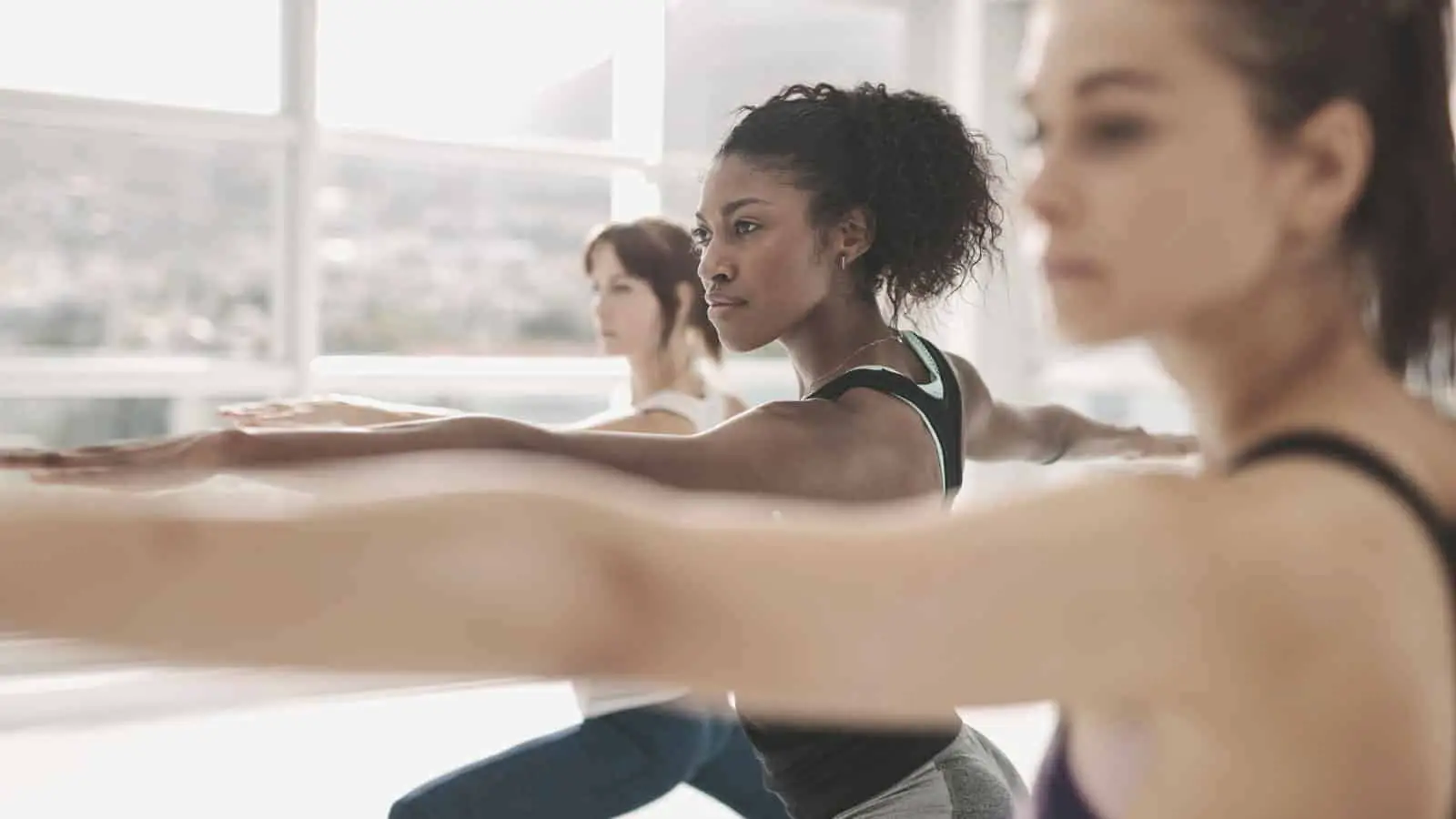When you practice yoga, you are putting yourself into bodily positions that intend to benefit you. Still, if done incorrectly or without an awareness of your own body, you can physically harm yourself.
The most common mistakes in yoga are competitiveness, not listening to your body’s limitations, and overdoing yoga. These are just a few things to consider when practicing yoga. If you avoid these common mistakes, you’ll have a very enjoyable and enlightening yoga practice.
Let’s take a look at common mistakes made in yoga and ways to avoid them. Some of these deal with direct effects on the body, while others are more indirect.
Don’t Forget To Breathe
Breath is the foundation of just about every yoga practice. The breath cultivates good blood and oxygen flow throughout the body so that you can move into the various yoga postures. The breath is also an essential resource for creating a deeper connection and awareness of yourself in yoga exercise.
It is essential, then, to breathe effectively throughout your practice. An instructor should provide breath cues to help you remember to breathe. It is not too uncommon for a yoga practitioner to hold their breath while they practice yoga. This may occur when a particular yoga pose is more challenging. Since the posture is potentially foreign or difficult, the body reacts by holding the breath. The lack of breath constricts blood flow and creates muscle tension that does not allow for ease and bodily flow when attempting any yoga posture. When things get tough, take a deep breath!
Align your body in asana

When you practice yoga postures, it is essential to be structurally sound when holding the position. This could be in a basic yoga pose like Mountain Pose (Tadasana) or a challenging yoga posture like Crow Pose (Bakasana). Aligning the body properly will create a stronger posture, and you’ll gain more from experience.
Let’s take a look at Warrior 2 (Virabhadrasana II) as an example of proper alignment. In such a pose, you are looking for safety in your joints and muscles so that you can hold the posture effectively. Aligning joints over joints is a good reminder for the practicing yogi.
In Warrior 2, you are standing in a lunge:
- the front leg is bent,
- the back leg is straight,
- both feet are firm on the floor,
- the upper body is opened with arms extended outward over the legs, respectively.
In this hip opening posture, you want to be aware of what is happening with the front leg that is bent at the knee.
A common mistake is having the knee aligning over the toes. This will create too much weight and pressure in the knee joint. Another mistake is having the knee shift to the inside of the foot. This contorts the knee in a way that may cause potential damage to the joint. Instead, be sure to stack the knee joint directly over the ankle bone. This creates a strong line of energy from bone to bone that will help you to engage your thigh muscle; this will allow for a structurally sound and safe posture.
Be aware of your joints
There are a couple of things you need to be aware of when you practice yoga in relation to your joints, in particular, your knees, wrists, elbows, and shoulders. It is important not to lock your knee and elbow joints when practicing some yoga poses.
When you lock the joints, pressure increases in these areas and does not allow for the muscles to engage. This causes damage to the joints over time and does not allow for the natural strength of the muscles to take place. An easy correction is to make sure you bend the knees and elbows a bit. That will take you out of the joint pressure and assures muscle engagement. This can be a problem for yogis that are double-jointed. They are more likely to settle into their joints in postures like Mountain Pose or Plank Pose. You may have to be more mindful in keeping the knees or elbows bent in order to avoid this common mistake.
Don’t compare yourself with others
One thing about yoga is that it is not a competitive practice. Although you may practice in a group or class, the focus is on yourself. There may be a tendency, though, to look around the room to see what the other yogis are doing. You examine how one person can touch her toes without bending her knees or how another yogi can stand on one foot without falling over.
You begin to compare yourself to the other yogis around you. This is a common mistake in a yoga class. The practice of yoga is purely about yourself; it’s a personal practice. There is no need to compare; you may end up criticizing yourself, which is contrary to what the practice is all about.
Don’t overdo yoga

This might catch you by surprise, but yes, it is possible to overdo yoga. Yoga is a practice in which we should grow, so giving the body time to get stronger into performing challenging asanas can prevent you from an injury.
While there is no exact way of knowing when we overdo yoga, the pain in the wrists, muscle fatigue, falling out from easy asanas might be the first signs that you overdo yoga. And don’t forget family! If they complain that lately, you choose yoga over them, listen to this message.
The truth is that just as we can’t build a stable house without a strong foundation, it is impossible to build a “difficult” asana without a proper foundation as well. It takes time. Yoga sequences and flows were created to help yogis build flexibility and strength. Think about Ashtanga yoga: beginner poses (primary series) help yogi build stamina, strength and prepare the body for advanced poses. You can’t expect to perform poses like Chakorasana, Ganda Bherundasana, or Eka-Pada Bakasana [B] without a proper foundation.
Be aware of yoga burnout
Yoga burnout is a consequence of overdoing yoga. It is easy to fall in love with yoga and the philosophy of it. Yogic lifestyle can become so exciting that we start believing we should do more yoga to justify ourselves as good yogis. The practices become longer, more intense, with less time to rest.
If you feel you started pushing (forcing) yourself to do yoga even though you feel extremely tired, and if after yoga you are more irritated rather than relaxed – these might be the first yoga burnout symptoms. Change in mood, weak body, avoiding yoga mat at any cost can follow right after that.
While yoga burnout is common and not much spoken about, it can easily be avoided by simply listening to your body. Please don’t push yourself too much and too fast into the practice, which teaches us patience, love, appreciation, and acceptance.
Be Safe And Comfortable
A few other things to note about practicing yoga is safety and comfort. If you happen to be in a Vinyasa yoga class, one that flows from one pose to the other without much of a break, you want to take your time. Move slowly. There is no need to push or assert yourself too aggressively in this style or any other style of yoga. Be gentle with yourself. You’ll experience more benefits if you take your practice at an easy pace.
Right yoga mat for your practice
Another area for safety (and comfort, too) is having the right yoga mat for your yoga practice. There have been times when instructors have seen students walk in with exercise mats (which are VERY different from yoga mats). Some mats are too slippery, don’t stick to the floor, or are the wrong size.
You want to have the best yoga mat that suits the yoga style you’re practicing. For example, if you’re attending an Ashtanga Yoga Class or a Hot Yoga Class, you’re more than likely to sweat a lot. You’ll want a good yoga mat with a towel top, so your hands and feet stay stable if your mat gets too wet.
Yoga wear
And the final thing about comfort is to wear something in which you can easily move. Not a good idea to wear heavy clothing to a yoga class. Often lightweight clothing like shorts and a t-shirt are sufficient. You also want to wear things that will not obstruct your practice. Flowing blouses or baggy pants may distract you while you’re trying to get into some of your poses. Leggings and less fluid tops are the way to go. Remember, you want your yoga practice to be about calm and ease, not about stress and distraction.
Closing thought
Practicing yoga is about tuning in, reflecting on yourself, being more aware of what is going on inside of you rather than outside. It doesn’t matter if you can’t touch your toes or if you topple out of a balancing pose. Arrive on your mat as you are and steadily watch your own personal progress and growth.









